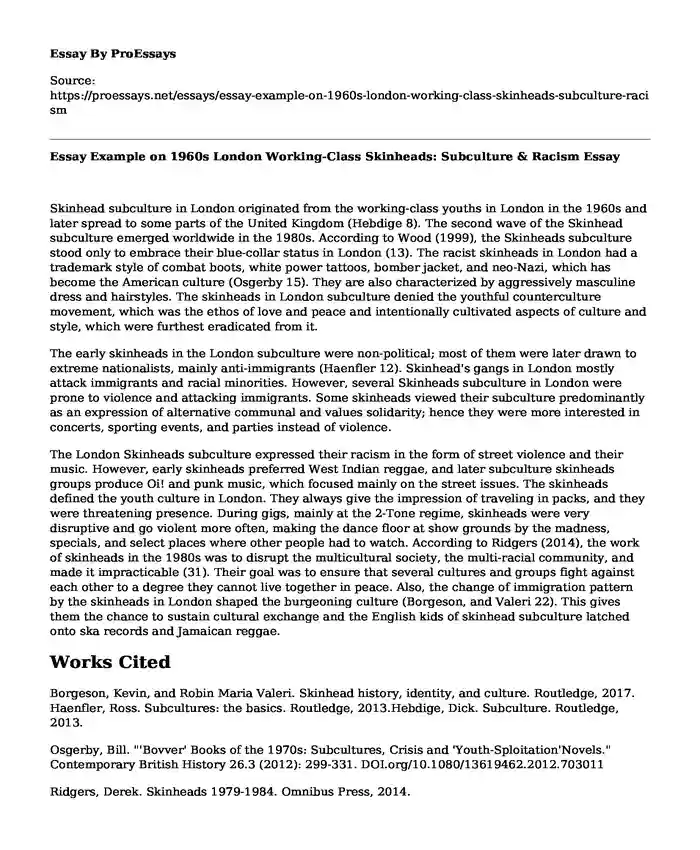Skinhead subculture in London originated from the working-class youths in London in the 1960s and later spread to some parts of the United Kingdom (Hebdige 8). The second wave of the Skinhead subculture emerged worldwide in the 1980s. According to Wood (1999), the Skinheads subculture stood only to embrace their blue-collar status in London (13). The racist skinheads in London had a trademark style of combat boots, white power tattoos, bomber jacket, and neo-Nazi, which has become the American culture (Osgerby 15). They are also characterized by aggressively masculine dress and hairstyles. The skinheads in London subculture denied the youthful counterculture movement, which was the ethos of love and peace and intentionally cultivated aspects of culture and style, which were furthest eradicated from it.
The early skinheads in the London subculture were non-political; most of them were later drawn to extreme nationalists, mainly anti-immigrants (Haenfler 12). Skinhead's gangs in London mostly attack immigrants and racial minorities. However, several Skinheads subculture in London were prone to violence and attacking immigrants. Some skinheads viewed their subculture predominantly as an expression of alternative communal and values solidarity; hence they were more interested in concerts, sporting events, and parties instead of violence.
The London Skinheads subculture expressed their racism in the form of street violence and their music. However, early skinheads preferred West Indian reggae, and later subculture skinheads groups produce Oi! and punk music, which focused mainly on the street issues. The skinheads defined the youth culture in London. They always give the impression of traveling in packs, and they were threatening presence. During gigs, mainly at the 2-Tone regime, skinheads were very disruptive and go violent more often, making the dance floor at show grounds by the madness, specials, and select places where other people had to watch. According to Ridgers (2014), the work of skinheads in the 1980s was to disrupt the multicultural society, the multi-racial community, and made it impracticable (31). Their goal was to ensure that several cultures and groups fight against each other to a degree they cannot live together in peace. Also, the change of immigration pattern by the skinheads in London shaped the burgeoning culture (Borgeson, and Valeri 22). This gives them the chance to sustain cultural exchange and the English kids of skinhead subculture latched onto ska records and Jamaican reggae.
Works Cited
Borgeson, Kevin, and Robin Maria Valeri. Skinhead history, identity, and culture. Routledge, 2017. Haenfler, Ross. Subcultures: the basics. Routledge, 2013.Hebdige, Dick. Subculture. Routledge, 2013.
Osgerby, Bill. "'Bovver' Books of the 1970s: Subcultures, Crisis and 'Youth-Sploitation'Novels." Contemporary British History 26.3 (2012): 299-331. DOI.org/10.1080/13619462.2012.703011
Ridgers, Derek. Skinheads 1979-1984. Omnibus Press, 2014.
Wood, Robert T. "The indigenous, nonracist origins of the American skinhead subculture." Youth & Society 31.2 (1999): 131-151. DOI.org/10.1177/0044118X99031002001
Cite this page
Essay Example on 1960s London Working-Class Skinheads: Subculture & Racism. (2023, Jul 02). Retrieved from https://proessays.net/essays/essay-example-on-1960s-london-working-class-skinheads-subculture-racism
If you are the original author of this essay and no longer wish to have it published on the ProEssays website, please click below to request its removal:
- Aspects of Colonialism and Racism in Selected Texts by Joseph Concard Essay
- Communication in the Fire Service Paper Example
- Understanding Human Development: An Essential Guide for Parents - Essay Sample
- Essay Example on Martin Okabi: A Young African's Inspiring Story of Overcoming Adversity
- Essay Sample on America's Identity: The Development of a Revolutionary System
- Essay Example on Stereotypes, Aging, and Society: An Exploration
- Annie Oakley: West America - Movie Review Sample







